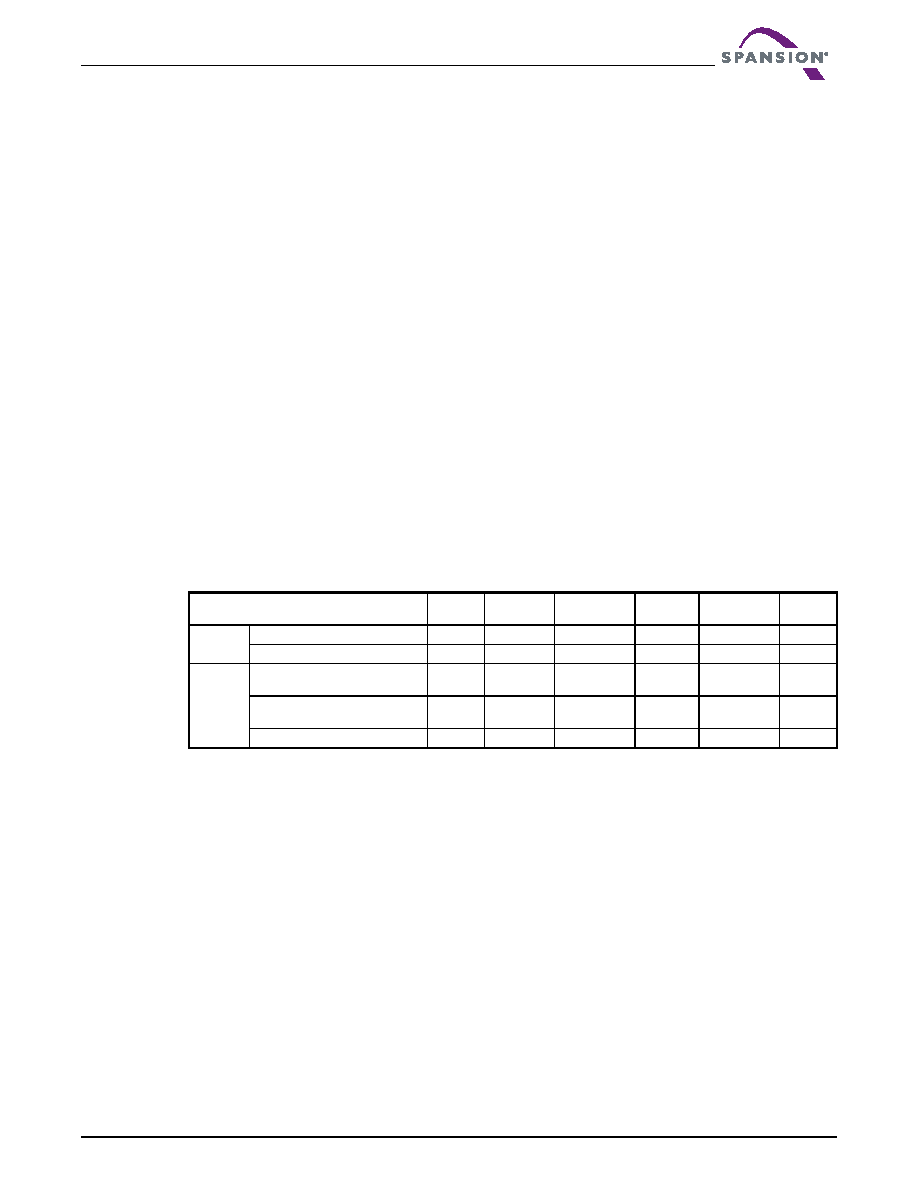- 您現(xiàn)在的位置:買賣IC網(wǎng) > PDF目錄225140 > S29AL016D90BAN012 (SPANSION LLC) 1M X 16 FLASH 3V PROM, 90 ns, PBGA48 PDF資料下載
參數(shù)資料
| 型號: | S29AL016D90BAN012 |
| 廠商: | SPANSION LLC |
| 元件分類: | PROM |
| 英文描述: | 1M X 16 FLASH 3V PROM, 90 ns, PBGA48 |
| 封裝: | 8.15 X 6.15 MM, FBGA-48 |
| 文件頁數(shù): | 29/55頁 |
| 文件大?。?/td> | 1809K |
| 代理商: | S29AL016D90BAN012 |
第1頁第2頁第3頁第4頁第5頁第6頁第7頁第8頁第9頁第10頁第11頁第12頁第13頁第14頁第15頁第16頁第17頁第18頁第19頁第20頁第21頁第22頁第23頁第24頁第25頁第26頁第27頁第28頁當(dāng)前第29頁第30頁第31頁第32頁第33頁第34頁第35頁第36頁第37頁第38頁第39頁第40頁第41頁第42頁第43頁第44頁第45頁第46頁第47頁第48頁第49頁第50頁第51頁第52頁第53頁第54頁第55頁

November 27, 2007 S29AL016D_00_A7
S29AL016D
35
Data
She e t
11.6
DQ5: Exceeded Timing Limits
DQ5 indicates whether the program or erase time has exceeded a specified internal pulse count limit. Under
these conditions DQ5 produces a 1. This is a failure condition that indicates the program or erase cycle was
not successfully completed.
The DQ5 failure condition may appear if the system tries to program a 1 to a location that is previously
programmed to 0. Only an erase operation can change a 0 back to a 1. Under this condition, the device
halts the operation, and when the operation has exceeded the timing limits, DQ5 produces a 1.
Under both these conditions, the system must issue the reset command to return the device to reading array
data.
11.7
DQ3: Sector Erase Timer
After writing a sector erase command sequence, the system may read DQ3 to determine whether or not an
erase operation has begun. (The sector erase timer does not apply to the chip erase command.) If additional
sectors are selected for erasure, the entire time-out also applies after each additional sector erase command.
When the time-out is complete, DQ3 switches from 0 to 1. The system may ignore DQ3 if the system can
guarantee that the time between additional sector erase commands will always be less than 50
μs. See
After the sector erase command sequence is written, the system should read the status on DQ7 (Data#
Polling) or DQ6 (Toggle Bit I) to ensure the device has accepted the command sequence, and then read
DQ3. If DQ3 is 1, the internally controlled erase cycle has begun; all further commands (other than Erase
Suspend) are ignored until the erase operation is complete. If DQ3 is 0, the device will accept additional
sector erase commands. To ensure the command has been accepted, the system software should check the
status of DQ3 prior to and following each subsequent sector erase command. If DQ3 is high on the second
status check, the last command might not have been accepted. Table 11.1 shows the outputs for DQ3.
Notes
1. DQ5 switches to 1 when an Embedded Program or Embedded Erase operation has exceeded the maximum timing limits. See DQ5:
Exceeded Timing Limits on page 35 for more information.
2. DQ7 and DQ2 require a valid address when reading status information. Refer to the appropriate subsection for further details.
Table 11.1 Write Operation Status
Operation
DQ7
DQ6
DQ5
DQ3
DQ2
RY/BY#
Standard
Mode
Embedded Program Algorithm
DQ7#
Toggle
0
N/A
No toggle
0
Embedded Erase Algorithm
0
Toggle
0
1
Toggle
0
Erase
Suspend
Mode
Reading within Erase
Suspended Sector
1
No toggle
0
N/A
Toggle
1
Reading within Non-Erase
Suspended Sector
Data
1
Erase-Suspend-Program
DQ7#
Toggle
0
N/A
0
相關(guān)PDF資料 |
PDF描述 |
|---|---|
| S29AL016M90FFI010 | 16 MEGABIT (2M X 8 BIT / I M X 16 BIT) 3.0 VOLT ONLY BOOT SECTOR FLASH MEMORY |
| S29AL016M10FFI010 | 16 MEGABIT (2M X 8 BIT / I M X 16 BIT) 3.0 VOLT ONLY BOOT SECTOR FLASH MEMORY |
| S29AL016M90FFI012 | 16 MEGABIT (2M X 8 BIT / I M X 16 BIT) 3.0 VOLT ONLY BOOT SECTOR FLASH MEMORY |
| S29AL016M10FFI012 | 16 MEGABIT (2M X 8 BIT / I M X 16 BIT) 3.0 VOLT ONLY BOOT SECTOR FLASH MEMORY |
| S29CD016G0MFAN002 | 16 Megabit (512 K x 32-Bit) CMOS 2.5 Volt-only Burst Mode, Dual Boot, Simultaneous Read/Write Flash Memory |
相關(guān)代理商/技術(shù)參數(shù) |
參數(shù)描述 |
|---|---|
| S29AL016D90BFI010 | 制造商:SPANSION 制造商全稱:SPANSION 功能描述:16 MEGABIT CMOS 3.0 VOLT ONLY BOOT SECTOR FLASH MEMORY |
| S29AL016D90BFI010(E) | 制造商:Spansion 功能描述: |
| S29AL016D90BFI013 | 制造商:SPANSION 制造商全稱:SPANSION 功能描述:16 MEGABIT CMOS 3.0 VOLT ONLY BOOT SECTOR FLASH MEMORY |
| S29AL016D90BFI020 | 制造商:Spansion 功能描述:SPZS29AL016D90BFI020 16M FLASH EOL100409 |
| S29AL016D90BFI020(E) | 制造商:Spansion 功能描述:Cut Tape |
發(fā)布緊急采購,3分鐘左右您將得到回復(fù)。